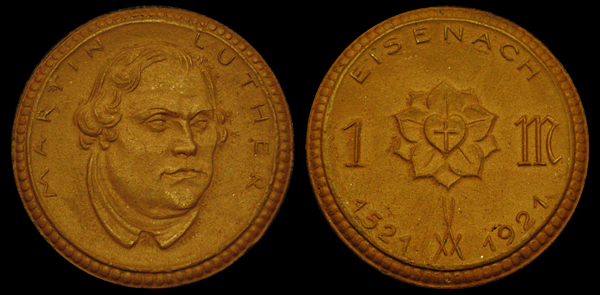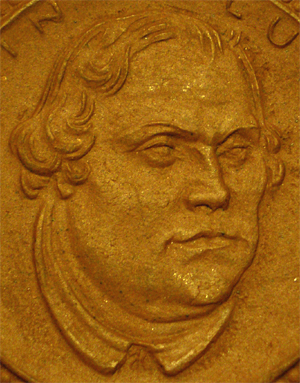
STADT EISENACH (GERMAN) 1 Mark 1921
City of Eisenach (Thuringia) Porcelain 1 Mark Coin Depicting Martin Luther and Luther's Seal. Dates Mark 400 Year since the Diet of Worms.
This porcelain 1 mark coin was issued by the City of Eisenach. On the obverse is a portrait of Martin Luther. The reverse shows the crossed swords of the Meissen Porcelain Works between two dates marking 400 years since the diet of worms.
The Diet of Worms, which would result in the issuance of the Edict of Worms, took place in Worms Germany in 1521 with the Holy Roman Emperor Charles V presiding. The Edict of Worms declared Martin Luther a criminal in word and deed for is opposition to the Catholic Church. It called for his arrest and offered a reward for his capture. This edict was never enforced as Martin Luther was taken during a planned highway attack by masked men sent by Frederick III (the Wise) Elector of Saxony of the House of Wettin, himself an ardent Protestant.
Frederick took Luther to Wartburg Castle which sits on a precipice overlooking the town of Eisenach. Luther had lived and studied in Eisenach as a young man. During his short time at Wartburg Castle he would translate the New Testament from Greek to German and issue new pronouncements, judgments, and fresh condemnations against the Catholic Church. The House of Wettin was based in Meissen which gave birth to the famous Meissen porcelain works who minted this reddish brown stoneware coin.
This coin displays the crossed swords found on every product of the Meissen porcelain works since 1722 including the white and brown porcelain coins and medals minted during this time. Although both white and brown porcelain coins and medals were produced, brown porcelain was often preferred over white for circulation due to the fact that it was less effected by dirt, breakage and wear. Although the use of porcelain for coins and medals was not a new concept as Meissen had produced its first porcelain medallion as far back as 1710, regular production of German porcelain coins as currency for a variety of towns, cities, and regains (emergency money and donation coins) began at the end of 1920 and in the first months of 1921.
A limited number of these coins were produced from plaster casts for Germany and for the State of Saxony. These earlier limited issue coins are remarkable for having finer, less sharp lines, rougher surfaces and are thinner than the ones later minted from steel moulds. Later issues such as the one pictured above were produced in large numbers from steel casts and are characterized by thicker flans and sharper detail. Porcelain coins with face values from 10 pfennigs to 20 marks were issued in a variety of types and numbers for many German cities and regions at the beginning of the 1920s. Although these coins were reportedly very popular do to their attractive, interesting and varied designs, they were impractical as coinage do to the fact that they broke rather easily and did not hold up the rigors of circulation for long. They ultimately failed as currency thus circulation of these coins was very limited though commemorative and special issue porcelain coins and medals continued to be produced.
 |
Obverse Detail |
